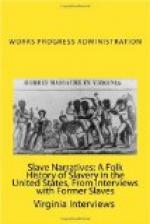“After the War, he worked on a steamboat. They used to kick the roustabouts about and run them around but they never laid the weight of their hands on him.
“They wouldn’t allow him to go to school in slavery time. After the War, he got a Blue Back Speller and would make a bowl of fire and at night he would study—sometimes until daybreak. Then he found an old man that would help him and he studied under him for a while. He never went to any regular school, but he went to night school a little. Most of what he got, he got himself.
“He was born in Louisville, Kentucky. I don’t know how he happened to meet my mother. During the time after the War, he went to running on the boat from New Orleans to Friar Point, Mississippi. Then he would come over to Helena. In going ’round, he met my mother near Marianna and married her.
“Mother never had much to say, and the other girls would have a big time talking. He noticed that she was sewing with ravelings and he said, ’Lady, next time I come I’ll bring you a spool of thread if you don’t mind.’ He brought the thread and she didn’t mind, and from then on, they went to courting. Finally they married. They married very shortly after the War.
“My mother was a motherless girl. My daddy said he looked at her struggling along. All the other girls were trying to have a good time. But she would be settin’ down trying to make a quilt or something else useful, and he said to a friend of his, ’That woman would make a good wife; I am going to marry her.’ And he did.
“She used to spin her fine and coarse sewing thread and yarn to make socks and stockings with. Her stockings and socks for the babies and papa would always be yarn. She could do pretty work. She had a large family. She had seventeen children and she kept them all in things she made herself. She raised ten of them. She would make the thread and yarn and the socks and stockings for all of these. I have known the time when she used to make coats and pants for my father and brothers. She would make them by hand because they didn’t have any machines then. Of course, she made all the underwear. She put up preserves and jellies for us to eat in the winter. She used to put up kraut and stuff by the barrel. I have seen some happy days when I was with my daddy and mother. He raised pigs and hogs and chickens and cows. He raised all kinds of peas and vegetables. He raised those things chiefly for the home, and he made cotton for money. He would save about eight or ten bales and put them under his shed for stockings and clothes and everything. He would have another cotton selling in March.
“When my father was in the army, he would sometimes be out in the weather, he told us, and he and the other soldiers would wrap up in their blankets and sleep right in the snow itself.
“I farmed all my life until 1897. I farmed all my life till then. I was at home. I married in 1895. My first husband and I made three crops and then he stopped and went to public work. After that I never farmed any more but went to cooking and doing laundry work. I came from Clarendon here in 1901.




